In the digital age, technology is quickly shaping up to tackle tough environmental problems. As more of us use tech, both companies and people are realizing the value of green actions. A study found that 73% of millennials prefer companies that are green.
Through new technology applications, groups can attract eco-minded customers while helping the planet. They use modern tools like big data and automation. Such tech is changing how we save our planet. Let’s dive into five key technologies that are cutting pollution and protecting our Earth.
Key Takeaways:
- Tech is increasingly being applied to fight global issues and win over environment-loving customers.
- 73% of millennials choose to support eco-conscious businesses.
- This article will look at five key technologies used to protect our planet.
- Data-driven insights and advanced automation are changing the game in environmental protection.
- Companies can use technology to be greener and attract more customers.
Revolutionizing Environmental Protection
New technologies are making a big difference in how we protect our planet. They include things like data analysis, remote sensing, smart grids, and precision agriculture. These tools are changing the game for keeping the earth healthy.
Data Analysis and Remote Sensing
The mix of data analysis and remote sensing is changing how we look after nature. Internet of Things (IoT) and sensors check things like air and water quality. They give us info we need to make smart choices for the environment.
Sustainable Practices: Smart Grids and Precision Agriculture
Smart grids and precision agriculture are becoming key in doing things in a eco-friendly way. Smart grids use high-tech sensor and automation to manage energy better. This helps cut waste and harm to the earth. Precision agriculture uses data and sensors too. It helps farmers use less water, fertilizer, and pesticides. This way, they can grow more food.
These new tech ways are not just helping nature. They’re also making sustainable use of resources easier. By using data and IoT, we’re finding tons of ways to protect the environment better.
Key Benefits of Environmental Technology

The world is facing big environmental issues. Environmental technology is now very important. It helps to save resources, stop waste, and improve our health and brains.
Conservation of Resources
Smart home systems and tools for digital work are key parts of this. They save energy and water. They use sensors and data to be more efficient.
For example, smart thermostats can lower energy use by adjusting on their own. Also, appliances and systems that save water are big parts of this.
Waste Elimination
Environmental tech is also crucial in reducing waste. From smart classrooms to high-tech recycling, it helps a lot. It makes our world and daily actions less harmful.
It does this by automating and improving how we use materials. This is making a ‘circular economy’ more possible. We’re moving towards a future that’s better for the planet.
Improvement of Our Health and Cognitive Abilities
But the benefits don’t stop there. New tech, like air monitors and smart urban plans, is making us healthier and smarter. By giving us data on air and water quality, it lets us make better choices.
This leads to healthier living and thinking. Plus, cleaner air and more efficient energy are good for our lungs and minds. It’s all making a big difference.
Sustainable Technologies and Their Impact
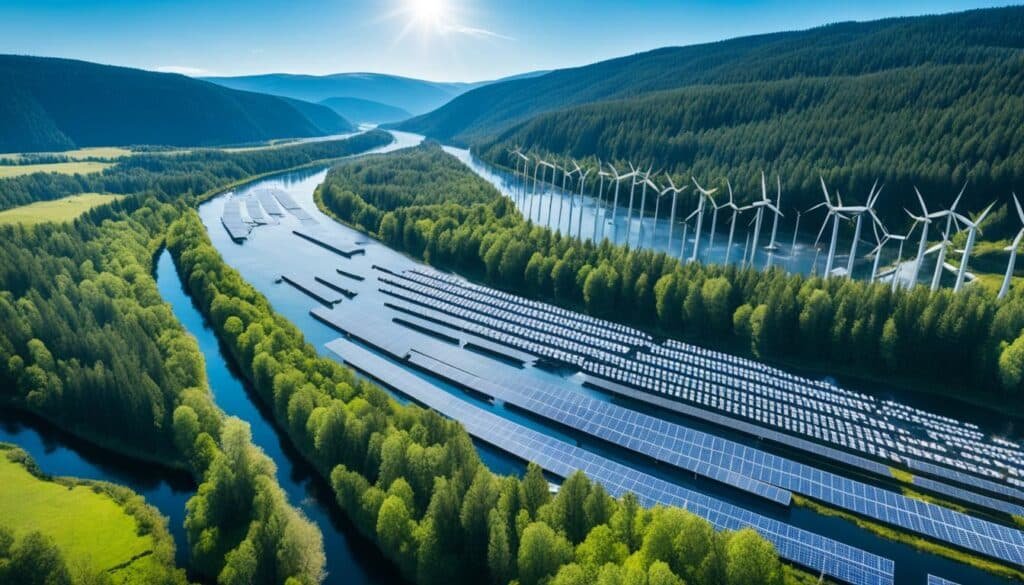
Sustainable technologies are now essential in fighting environmental challenges. They can lower emissions, save resources, and lessen the impact of our actions on the Earth. We will look into some key sustainable technologies and how they help the planet.
Carbon Capture and Storage (CCS)
CCS captures CO2 from industry and power plants to stop it entering the air. Then, it either stores it underground or uses it in other ways. This helps cut down on greenhouse gases, which are a big factor in climate change.
Solar Glass
Solar glass puts solar cells into the glass of buildings and vehicles. It generates solar power while looking like regular glass. This boosts energy efficiency and cuts our use of traditional power, aiding sustainable energy efforts.
Smart Grids
Smart grids are a key feature of modern energy management. They use sensors, data tech, and communication to improve efficiency and add renewable energy. They are crucial for updating our power network, cutting emissions, and creating a more lasting energy system.
Environmental Sensors
These sensors collect data on air and water quality, soil, and pollution. When linked to the Internet of Things, they offer real-time data for making smart choices. They also help shape policies and strategies for dealing with pollution.
LED Lighting
LED lights are changing the lighting game, offering better efficiency and longer life. They use less power, thus reducing emissions and saving energy. Their wide use in many places helps a lot in the drive for sustainable energy.
| Sustainable Technology | Environmental Impact | Key Benefits |
|---|---|---|
| Carbon Capture and Storage (CCS) | Reduces greenhouse gas emissions from industrial and power generation sources | Mitigates climate change, supports emissions reduction targets |
| Solar Glass | Generates renewable solar energy while maintaining glass transparency | Enhances energy efficiency, reduces reliance on conventional energy sources |
| Smart Grids | Optimizes energy distribution, integrates renewable energy sources, and enables energy storage | Improves energy efficiency, supports the transition to sustainable energy systems |
| Environmental Sensors | Monitors air quality, water purity, soil composition, and pollution levels | Provides real-time data for informed decision-making, supports effective environmental policies |
| LED Lighting | Significantly reduces energy consumption and emissions compared to traditional lighting | Contributes to substantial energy savings and emissions reduction |
Technology Applications Reducing Paper Waste

The paper industry plays a big part in harming the environment. It is the third top polluter in the U.S. This sector produces over 100 million kg of toxic waste annually. It also leads to 15% of global greenhouse gas emissions and is a main cause of the loss of 18 million acres of forest each year. Luckily, the use of paperless and data digitization is helping fight this problem.
By switching to electronic forms and mobile forms, companies can cut down on their use of paper. These tech solutions make work easier and save trees. They also lower the harmful greenhouse gas emissions from printing. And, by going green, companies show they care about the planet. This wins over customers who also want to protect the earth.
| Technology Application | Environmental Impact |
|---|---|
| Electronic Forms | Less paper waste and fewer trees cut, smaller carbon footprint, and better data digitization |
| Mobile Forms | Easier data collection, smoother paperless operations, and fewer greenhouse gas emissions |
Using these new technology applications means companies can have a big positive effect on the planet. They can become leaders in being eco-friendly. This builds trust with people who care about the environment. And it all helps make the world greener.
Negative Impact of Technology on the Environment
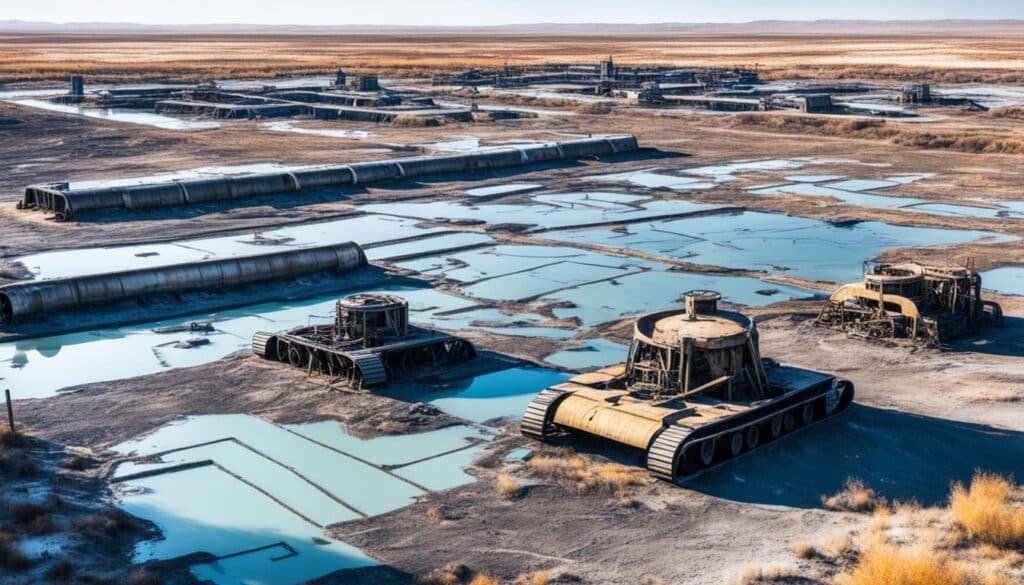
The industrial revolution and modern tech have made life better in many ways. At the same time, they’ve caused negative impact on the environment. This damage ranges from air and water pollution to the depletion of natural resources.
Air and Water Pollution
Fossil fuels are burned for energy in our factories, cars, and homes. This creates a lot of greenhouse gas emissions. The result is air pollution and climate change. On top of that, waste from industries and poor disposal practices pollute water bodies. This harms both aquatic life and people.
Depletion of Natural Resources
We’re always needing more materials for our tech growth. This has led to the depletion of natural resources like minerals, ores, and trees. The methods used, like mining and deforestation, damage ecosystems. This causes loss of plant and animal life, and we’re losing these essential resources.
It’s key that we think about the effects of our tech advances on the planet. We need to look at environmental consequences and find ways to be sustainable. This means using less resources and causing less pollution. By doing so, we can make technology work for a better, more eco-friendly world.
The Paradox: Technology as Part of the Problem and Solution
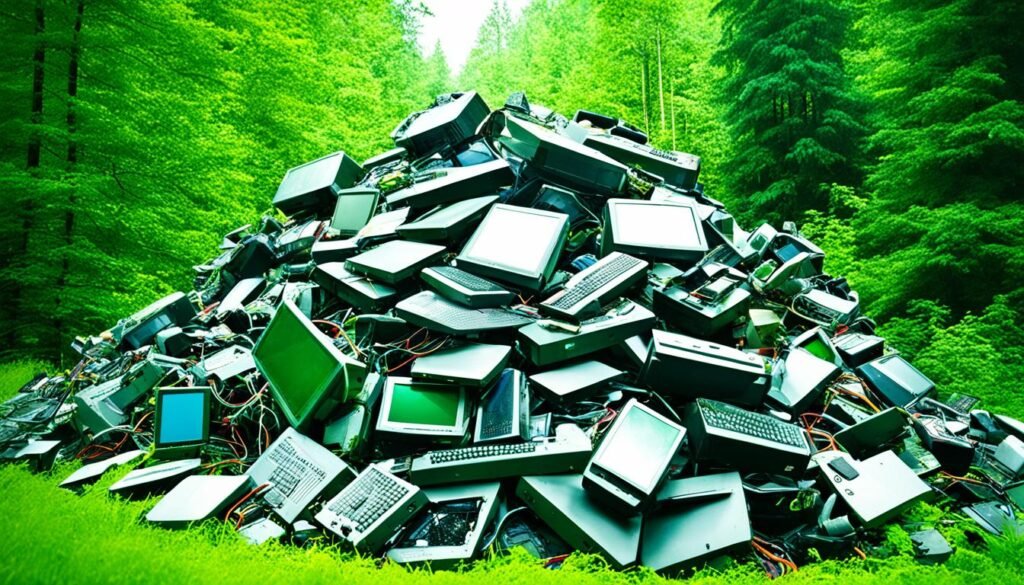
The link between technology and our planet can seem confusing. Technology has rapidly evolved, leading to lots of problems like environmental impact and climate change. It’s made pollution and greenhouse gas emissions worse. Yet, solving these issues might also need technology.
People all over the world are working hard to lessen technology’s harm on the earth. They’re focusing on green technology and clean technology. This includes things like renewable energy, smart systems, and electric cars. These efforts are key in fighting climate change and saving our resources.
This situation makes it clear that technology can be both good and bad for our planet. How we use and develop technology matters a lot. We can use its potential to make the future better for the environment. This needs to balance new ideas with protecting nature.
| Technology as Problem | Technology as Solution |
|---|---|
| Increased resource scarcity and depletion due to overexploitation | Renewable energy sources like solar, wind, and geothermal power |
| Air and water pollution from industrial processes and emissions | Smart-grid systems and clean technology to optimize energy use and reduce waste |
| Greenhouse gas emissions contributing to climate change | Electric vehicles and other sustainable transportation solutions |
By understanding and wisely using technology, we can solve the environmental challenges it brought. This is key to a future that’s better for both us and the earth.
Environmental Technology Development
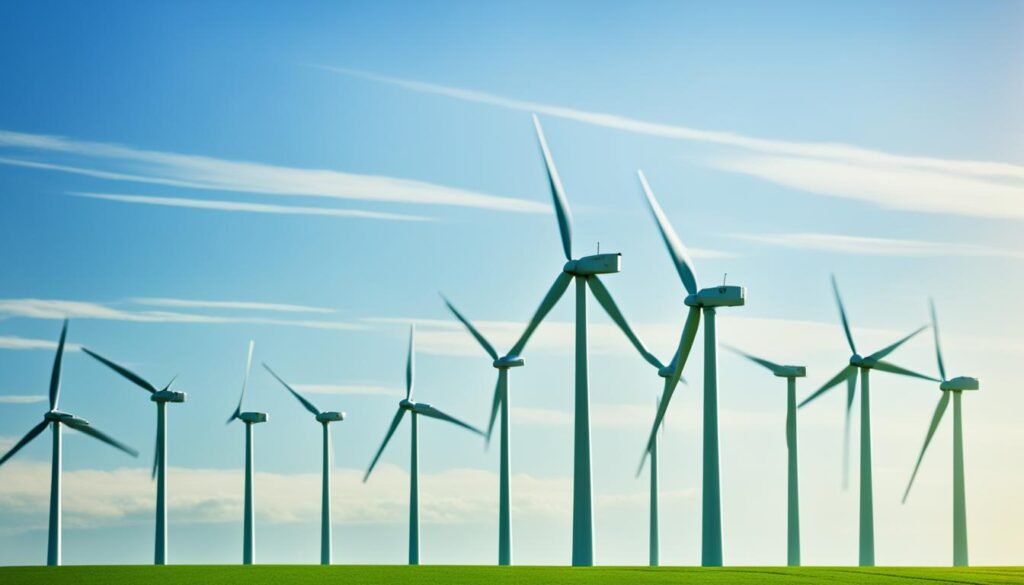
The world faces many tough environmental issues. So, working on environmental technology is super important now. Let’s explore key tech areas helping us reduce waste, cut emissions, and use energy better.
Renewable Energy
We’re turning more to renewable energy like solar, wind, and geothermal power thanks to new tech. These include better photovoltaic cells and wind turbines. The cool part? Not only do they slash greenhouse gas emissions, but they also help our homes and cities get smarter. This makes energy use more efficient and sustainable.
Smart Technology and the Internet of Things (IoT)
The Internet of Things (IoT) is changing how we protect our planet. It uses sensors and smart devices to watch environmental conditions and adjust. Think about how smart homes and smart cities are getting better. All thanks to IoT, we’re using resources smarter and reducing waste.
Electric Vehicles
Cars and trucks are big on causing greenhouse gas emissions. But with electric vehicles (EVs), things are looking up. EV tech is getting better too. This makes EVs a good choice for more people. As more EVs hit the road, we’re cutting pollution and making transportation less harmful to the environment.
| Technology | Key Benefits |
|---|---|
| Renewable Energy | Reduced greenhouse gas emissions, increased energy efficiency, development of smart homes and smart cities |
| Smart Technology and IoT | Real-time data collection and analysis, informed decision-making, optimization of sustainable practices |
| Electric Vehicles | Reduced emissions, promotion of sustainability in the transportation sector |
Combating Air Pollution with Digital Solutions
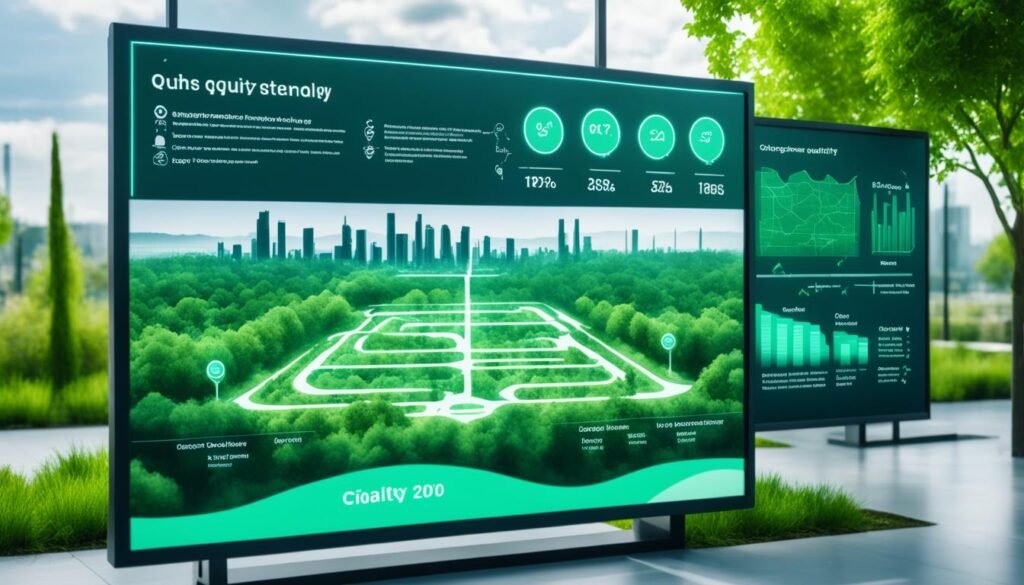
The world is up against a big challenge with air pollution. The United Nations Environment Programme (UNEP) is leading the way in using digital solutions to tackle this major issue. These new solutions use data, technology, and teamwork to get a grip on air pollution worldwide.
Global Environment Monitoring System for Air (GEMS Air)
GEMS Air is at the heart of UNEP’s efforts, connecting real-time air quality data from stations across the globe. This environmental monitoring system helps leaders, scientists, and the public understand air pollution’s impact. It combines data from all over to show the big picture on air quality. This insight helps in focusing efforts to fight air pollution and work on sustainability.
Freshwater Ecosystem Explorer
UNEP knows the importance of freshwater ecosystems and has introduced the Freshwater Ecosystem Explorer. This online data platform covers the status of lakes, rivers, and wetlands, including biodiversity and water quality. With the latest tech, it highlights what needs immediate climate action. This way, we can better look after these crucial natural areas.
International Methane Emissions Observatory (IMEO)
Methane does a lot of harm, as it strongly affects climate change. Recognizing that, UNEP created the International Methane Emissions Observatory (IMEO). This effort uses space data, on-the-ground readings, and smart analysis to spot and measure methane emissions. With clear, trustworthy data, policymakers and businesses can focus on reducing their emissions.
United Nations Biodiversity Lab 2.0
Protecting biodiversity is key to our planet’s future. The United Nations Biodiversity Lab 2.0 is part of UNEP’s strategy, using geospatial data and high-tech tools. It gathers data from many sources, giving a full picture of biodiversity worldwide. This informs better conservation and restoration plans.
UNEP’s digital efforts highlight the important role of technology in fighting climate change, air pollution, and saving species. By using environmental monitoring and digital platforms, along with teamwork, UNEP is driving towards a greener, stronger future.
Also Read: Navigating The Digital Frontier: Insights From A Technology Consultant
Technology Applications for Environmental Monitoring
Today’s world faces some big environmental problems. Luckily, we have new tech to help us watch our planet better. This tech helps us gather lots of data quickly and use it to make smart choices about things like climate change, pollution, and loss of plants and animals.
The Global Environment Monitoring System for Air (GEMS Air) is a cool digital project by the United Nations. It uses info from sensors on the ground, from satellites, and other places. This gives us a real-time look at how much air pollution is out there. It helps leaders and people know what to do to fight bad air and its health problems.
There’s also the Freshwater Ecosystem Explorer, another United Nations project. It looks at fresh water all around the world. By checking up on the water’s quality, how much there is, and the health of the life in it, this project helps folks make choices to guard our precious water better.
Our tech is even helping out with methane, a gas that heats up the Earth. The International Methane Emissions Observatory (IMEO) looks for methane in the air. It uses satellites and ground sensors to find where the gas is coming from. Then, it helps us plan how to stop it, which is a big deal in fighting climate change.
FAQs
Q: How are technology applications helping to protect the environment?
A: Technology applications are playing a significant role in environmental protection by enabling the development of sustainable practices, monitoring pollution levels, optimizing resource utilization, and promoting eco-friendly solutions.
Q: What are some examples of current technology applications for environmental protection?
A: Some current technology applications include renewable energy systems, smart grids for efficient energy distribution, IoT devices for environmental monitoring, and innovative waste management solutions.
Q: How do technology applications and implications impact environmental conservation efforts?
A: Technology applications have a dual impact on environmental conservation – while they can contribute to environmental degradation if not used responsibly, they can also be harnessed to address pressing environmental challenges and promote sustainability.
Q: How can individuals incorporate technology applications into their daily lives to support environmental protection?
A: Individuals can utilize technology applications such as energy-saving devices, smart home systems, eco-friendly transportation options, and sustainable lifestyle apps to reduce their ecological footprint and support environmental protection efforts.
Q: What role do emerging technologies play in environmental protection?
A: Emerging technologies like artificial intelligence, blockchain, and advanced analytics are being leveraged to develop innovative solutions for environmental conservation, climate change mitigation, biodiversity preservation, and sustainable resource management.
Q: How can schools integrate technology applications into environmental education?
A: Schools can incorporate technology applications, such as instructional apps, digital tools for environmental simulations, and online resources for exploring ecological concepts, to enhance students’ understanding of environmental issues and foster a sense of environmental stewardship.
Q: Who can be contacted for more information on technology applications for environmental protection?
A: For more information on technology applications for environmental protection, you can reach out to relevant organizations, environmental NGOs, technology companies specializing in sustainability, or educational institutions offering programs in environmental science and technology applications.
Source Links
- https://www.doforms.com/technologies-that-help-environment/
- https://edinburghsensors.com/news-and-events/environmental-technology-the-impact-of-technology-on-the-environment-and-environmental-technology/
- https://www.unep.org/news-and-stories/story/how-digital-technology-and-innovation-can-help-protect-planet




